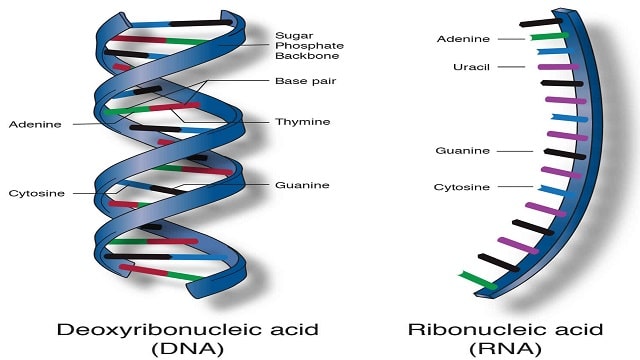Nucleic Acid Meaning
Nuclein (now called nucleic acids) is an acidic substance present in cell nuclei, with a large amount of phosphates, which was isolated in 1869 by the Swiss biologist Johan Friedrich Miescher, still a student at the time, who was analyzing pus residues left after surgery. His research allowed for future, more in-depth studies. By means of the technique of X-ray crystallography, the structure of DNA could be determined in 1953.
The union of three simple molecules (orthophosphoric acid, a nitrogenous base, and a pentose) form mononucleotides, which in turn give rise to nucleic acids, by joining together by means of covalent bonds, of the phosphodiester type.
Nucleic acids are large polymers that can form chains with millions of nucleotides, which serve the function of transmitting hereditary traits because they store genetic information within them.
Types of Nucleic Acid
Two types can be recognized within the nucleic acids: DNA or deoxyribonucleic acid, which has the capacity to self-duplicate, is the essential constituent element of the cell nucleus, composed of two polynucleotide chains arranged in a spiral on an axis. A purine or pyrimidine base accompanies each deoxyribose molecule that allows, by means of hydrogen bonds that originate between the complementary bases, to keep the two chains together; and RNA or ribonucleic acid, which is abundant in the nucleolus and in the cytoplasm, which has a single chain, its pentose being ribose and not deoxyribose, as does DNA, and its molecular mass is lower.
Nucleic Acid Meaning in Hindi
न्यूक्लिन (जिसे अब न्यूक्लिक एसिड(Nucleic Acid) कहा जाता है) कोशिका नाभिक में मौजूद एक अम्लीय पदार्थ है, जिसमें बड़ी मात्रा में फॉस्फेट होते हैं, जिसे 1869 में स्विस जीवविज्ञानी जोहान फ्रेडरिक मिशर ने अलग किया था, जो उस समय भी एक छात्र थे, जो सर्जरी के बाद बचे हुए मवाद के अवशेषों का विश्लेषण कर रहे थे। उनके शोध ने भविष्य में और अधिक गहन अध्ययन की अनुमति दी। एक्स-रे क्रिस्टलोग्राफी की तकनीक के माध्यम से, 1953 में डीएनए की संरचना निर्धारित की जा सकी।
तीन सरल अणुओं (ऑर्थोफॉस्फोरिक एसिड, एक नाइट्रोजनस बेस और एक पेंटोस) का मिलन मोनोन्यूक्लियोटाइड बनाता है, जो बदले में फॉस्फोडाइस्टर प्रकार के सहसंयोजक बंधों के माध्यम से एक साथ जुड़कर न्यूक्लिक एसिड को जन्म देते हैं।
न्यूक्लिक एसिड बड़े पॉलिमर होते हैं जो लाखों न्यूक्लियोटाइड के साथ श्रृंखला बना सकते हैं, जो वंशानुगत लक्षणों को प्रसारित करने का कार्य करते हैं क्योंकि वे अपने भीतर आनुवंशिक जानकारी संग्रहीत करते हैं।
न्यूक्लिक एसिड के प्रकार(Types of Nucleic Acid)
न्यूक्लिक एसिड के भीतर दो प्रकार पहचाने जा सकते हैं: डीएनए या डीऑक्सीराइबोन्यूक्लिक एसिड, जिसमें स्वयं-प्रतिकृति की क्षमता होती है, कोशिका नाभिक का आवश्यक घटक तत्व है, जो एक अक्ष पर एक सर्पिल में व्यवस्थित दो पॉलीन्यूक्लियोटाइड श्रृंखलाओं से बना होता है। प्रत्येक डीऑक्सीराइबोज अणु के साथ एक प्यूरीन या पाइरीमिडीन बेस होता है जो पूरक बेस के बीच उत्पन्न होने वाले हाइड्रोजन बॉन्ड के माध्यम से दो चेन को एक साथ रखने की अनुमति देता है; और आरएनए या राइबोन्यूक्लिक एसिड, जो न्यूक्लियोलस और साइटोप्लाज्म में प्रचुर मात्रा में होता है, जिसमें एक ही चेन होती है, इसका पेंटोज़ राइबोज होता है न कि डीऑक्सीराइबोज, जैसा कि डीएनए में होता है, और इसका आणविक द्रव्यमान कम होता है।

